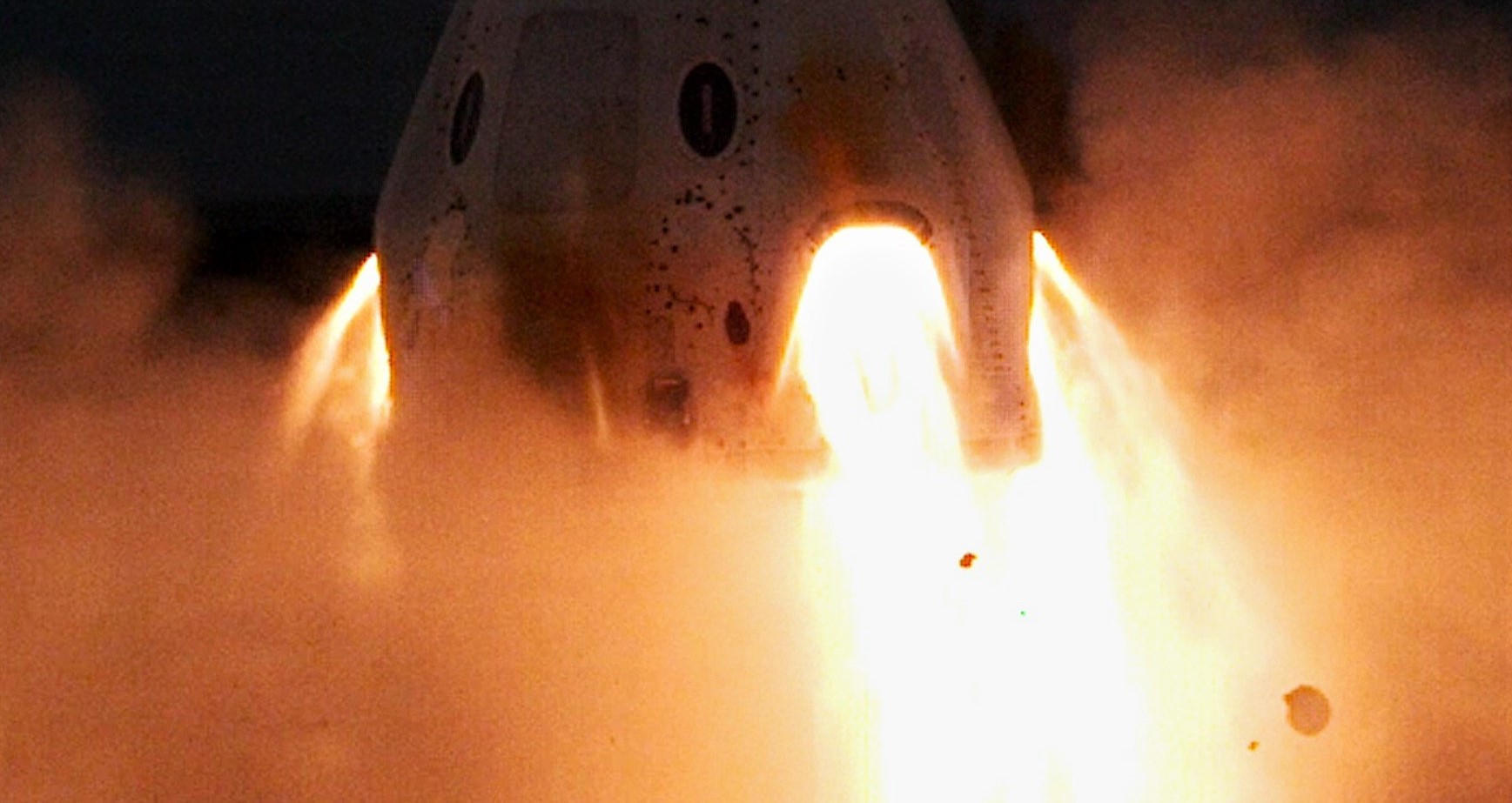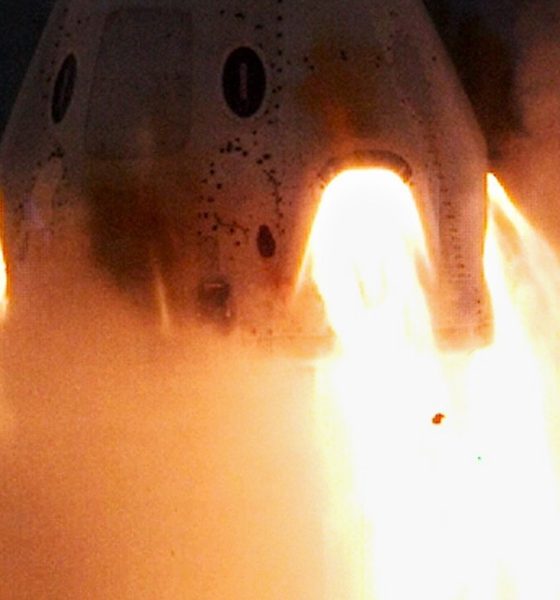

News
SpaceX says crew spacecraft abort test still on track for 2019 launch
NASA recently invited members of the media to apply for access to SpaceX’s Crew Dragon in-flight abort (IFA) test and, as of December 5th, the company reaffirmed that the crucial test is still on track to launch just weeks from now.
In September, SpaceX CEO Elon Musk revealed that Crew Dragon’s IFA spacecraft and Falcon 9 was scheduled to arrive in Florida within a few weeks. Days later, NASA confirmed that the rocket and spacecraft arrived in Florida on October 3rd, sooner, in fact, than Musk had predicted. Over the next few weeks, SpaceX technicians and engineers effectively closed out Crew Dragon capsule C205, priming it for operations and installing its body panels.
On November 13th, about six weeks after arriving in Florida, SpaceX successfully tested Crew Dragon’s redesigned propellant plumbing and high-pressure gas systems by static firing its Draco thrusters and SuperDraco abort engines. The successful static fire test lasted around 9 seconds, mirroring the SuperDraco impulse and thruster inputs the spacecraft would need to demonstrate in an actual in-flight abort. Crew Dragon has four sets of two SuperDraco engines capable of producing a combined thrust of more than 130,000 lbs (570 kN), almost as much thrust as the original SpaceX Merlin 1D engines used on Falcon 9 in the early 2010s.
Meant to verify that SpaceX has successfully redesigned Crew Dragon after the spacecraft suffered a catastrophic explosion during a very similar static fire attempt, November 13th’s was followed by an exhaustive hardware inspection and data review, some of which is likely still ongoing. Although NASA’s media invite suggests that a given launch event could be just a month or so away, there is a ton of uncertainty when dealing with major launches of new hardware (like Crew Dragon), meaning delays are all but guaranteed.
During a pre-launch media briefing ahead of SpaceX’s CRS-19 Cargo Dragon launch, director of Dragon mission management Jessica Jensen answered a question about Crew Dragon’s IFA test, cautiously stating that SpaceX teams are “targeting [a] December” launch. During SpaceX’s December 5th CRS-19 launch webcast, Dragon Engineering Manager John Federspiel briefly brought up Crew Dragon, noting that SpaceX was completing “minor refurbishment” following its successful static fire.
Most notably, he stated the IFA test was “targeted for February of 2020”, while Crew Dragon’s subsequent ‘Demo-2’ astronaut launch debut was expected to follow no earlier than (NET) “the first quarter of [2020]”, implying either February or March.
As it happened, SpaceX and several media outlets almost immediately attempted to correct the record, instead suggesting that Crew Dragon’s abort test is still tracking towards a launch later this month. Given that a senior Dragon engineering manager was the one to unblinkingly – and without correction – state that IFA is NET February 2020, there’s a strong possibility that he is technically correct but was not supposed to publicize the mission’s delay. At the same time, SpaceX appears to be firm on its claim that IFA is still aiming for a late-December launch. Delays would be no surprise – Crew Dragon’s Demo-1 launch debut took an agonizing three months to go from heading to the launchpad for the first to actually lifting off, almost entirely due to minor technical bugs and NASA paperwork.
Regardless, with less than four weeks left in 2019, SpaceX has an exceptionally tight schedule ahead of it to meet that December 2019 IFA launch goal and will effectively have to static fire IFA’s Falcon 9 before the end of the week or crush Crew Dragon’s inaugural processing time by at least a factor of four to achieve it. As such, a delay in 2020 should be all but expected at this point. With any luck, however, Crew Dragon will successfully perform its in-flight abort within the next 4-8 weeks, leaving SpaceX in a good place to prepare for its inaugural astronaut launch a few months later.
Check out Teslarati’s Marketplace! We offer Tesla accessories, including for the Tesla Cybertruck and Tesla Model 3.

Elon Musk
Starlink passes 9 million active customers just weeks after hitting 8 million
The milestone highlights the accelerating growth of Starlink, which has now been adding over 20,000 new users per day.

SpaceX’s Starlink satellite internet service has continued its rapid global expansion, surpassing 9 million active customers just weeks after crossing the 8 million mark.
The milestone highlights the accelerating growth of Starlink, which has now been adding over 20,000 new users per day.
9 million customers
In a post on X, SpaceX stated that Starlink now serves over 9 million active users across 155 countries, territories, and markets. The company reached 8 million customers in early November, meaning it added roughly 1 million subscribers in under seven weeks, or about 21,275 new users on average per day.
“Starlink is connecting more than 9M active customers with high-speed internet across 155 countries, territories, and many other markets,” Starlink wrote in a post on its official X account. SpaceX President Gwynne Shotwell also celebrated the milestone on X. “A huge thank you to all of our customers and congrats to the Starlink team for such an incredible product,” she wrote.
That growth rate reflects both rising demand for broadband in underserved regions and Starlink’s expanding satellite constellation, which now includes more than 9,000 low-Earth-orbit satellites designed to deliver high-speed, low-latency internet worldwide.
Starlink’s momentum
Starlink’s momentum has been building up. SpaceX reported 4.6 million Starlink customers in December 2024, followed by 7 million by August 2025, and 8 million customers in November. Independent data also suggests Starlink usage is rising sharply, with Cloudflare reporting that global web traffic from Starlink users more than doubled in 2025, as noted in an Insider report.
Starlink’s momentum is increasingly tied to SpaceX’s broader financial outlook. Elon Musk has said the satellite network is “by far” the company’s largest revenue driver, and reports suggest SpaceX may be positioning itself for an initial public offering as soon as next year, with valuations estimated as high as $1.5 trillion. Musk has also suggested in the past that Starlink could have its own IPO in the future.
News
NVIDIA Director of Robotics: Tesla FSD v14 is the first AI to pass the “Physical Turing Test”
After testing FSD v14, Fan stated that his experience with FSD felt magical at first, but it soon started to feel like a routine.

NVIDIA Director of Robotics Jim Fan has praised Tesla’s Full Self-Driving (Supervised) v14 as the first AI to pass what he described as a “Physical Turing Test.”
After testing FSD v14, Fan stated that his experience with FSD felt magical at first, but it soon started to feel like a routine. And just like smartphones today, removing it now would “actively hurt.”
Jim Fan’s hands-on FSD v14 impressions
Fan, a leading researcher in embodied AI who is currently solving Physical AI at NVIDIA and spearheading the company’s Project GR00T initiative, noted that he actually was late to the Tesla game. He was, however, one of the first to try out FSD v14.
“I was very late to own a Tesla but among the earliest to try out FSD v14. It’s perhaps the first time I experience an AI that passes the Physical Turing Test: after a long day at work, you press a button, lay back, and couldn’t tell if a neural net or a human drove you home,” Fan wrote in a post on X.
Fan added: “Despite knowing exactly how robot learning works, I still find it magical watching the steering wheel turn by itself. First it feels surreal, next it becomes routine. Then, like the smartphone, taking it away actively hurts. This is how humanity gets rewired and glued to god-like technologies.”
The Physical Turing Test
The original Turing Test was conceived by Alan Turing in 1950, and it was aimed at determining if a machine could exhibit behavior that is equivalent to or indistinguishable from a human. By focusing on text-based conversations, the original Turing Test set a high bar for natural language processing and machine learning.
This test has been passed by today’s large language models. However, the capability to converse in a humanlike manner is a completely different challenge from performing real-world problem-solving or physical interactions. Thus, Fan introduced the Physical Turing Test, which challenges AI systems to demonstrate intelligence through physical actions.
Based on Fan’s comments, Tesla has demonstrated these intelligent physical actions with FSD v14. Elon Musk agreed with the NVIDIA executive, stating in a post on X that with FSD v14, “you can sense the sentience maturing.” Musk also praised Tesla AI, calling it the best “real-world AI” today.
News
Tesla AI team burns the Christmas midnight oil by releasing FSD v14.2.2.1
The update was released just a day after FSD v14.2.2 started rolling out to customers.

Tesla is burning the midnight oil this Christmas, with the Tesla AI team quietly rolling out Full Self-Driving (Supervised) v14.2.2.1 just a day after FSD v14.2.2 started rolling out to customers.
Tesla owner shares insights on FSD v14.2.2.1
Longtime Tesla owner and FSD tester @BLKMDL3 shared some insights following several drives with FSD v14.2.2.1 in rainy Los Angeles conditions with standing water and faded lane lines. He reported zero steering hesitation or stutter, confident lane changes, and maneuvers executed with precision that evoked the performance of Tesla’s driverless Robotaxis in Austin.
Parking performance impressed, with most spots nailed perfectly, including tight, sharp turns, in single attempts without shaky steering. One minor offset happened only due to another vehicle that was parked over the line, which FSD accommodated by a few extra inches. In rain that typically erases road markings, FSD visualized lanes and turn lines better than humans, positioning itself flawlessly when entering new streets as well.
“Took it up a dark, wet, and twisty canyon road up and down the hill tonight and it went very well as to be expected. Stayed centered in the lane, kept speed well and gives a confidence inspiring steering feel where it handles these curvy roads better than the majority of human drivers,” the Tesla owner wrote in a post on X.
Tesla’s FSD v14.2.2 update
Just a day before FSD v14.2.2.1’s release, Tesla rolled out FSD v14.2.2, which was focused on smoother real-world performance, better obstacle awareness, and precise end-of-trip routing. According to the update’s release notes, FSD v14.2.2 upgrades the vision encoder neural network with higher resolution features, enhancing detection of emergency vehicles, road obstacles, and human gestures.
New Arrival Options also allowed users to select preferred drop-off styles, such as Parking Lot, Street, Driveway, Parking Garage, or Curbside, with the navigation pin automatically adjusting to the ideal spot. Other refinements include pulling over for emergency vehicles, real-time vision-based detours for blocked roads, improved gate and debris handling, and Speed Profiles for customized driving styles.








